1426 Farewell to the silent past
The Atheneum
by Trevor Newland
Vancouver: Simply Read Books, 2021
$23.95 / 9781772290622
Reviewed by Peter Babiak
*
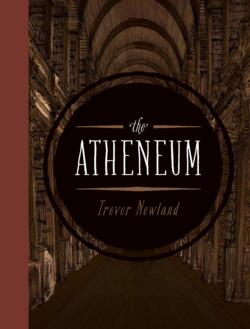 Whenever I’ve had the pleasure of teaching Children’s or Young Adult Literature, or even Graphic Novels, I’ve suspected that some students think the readings will be quick and easy, and that the critical thinking they’re called to do relatively lax. But all good literature, not just these genres, strive to engage the expanse of intellect and imagination through simple plots and relatable characters. This is in part what William Blake was driving at in “Auguries of Innocence,” a poem whose theme is in line with any consideration of the literature we suggest for young readers: “To see a World in a Grain of Sand / And a Heaven in a Wild Flower / Hold Infinity in the palm of your hand / And Eternity in an hour.” These lines remind us that, at its best, lucid and unassuming writing delivers thoughtful, intelligent content is ultimately the purpose of reading. This is what Trevor Newland does in The Atheneum, a stylishly illustrated and extraordinarily intelligent work of Children’s Literature that really is, as the biographical page indicates, a story “for young AND old people.”
Whenever I’ve had the pleasure of teaching Children’s or Young Adult Literature, or even Graphic Novels, I’ve suspected that some students think the readings will be quick and easy, and that the critical thinking they’re called to do relatively lax. But all good literature, not just these genres, strive to engage the expanse of intellect and imagination through simple plots and relatable characters. This is in part what William Blake was driving at in “Auguries of Innocence,” a poem whose theme is in line with any consideration of the literature we suggest for young readers: “To see a World in a Grain of Sand / And a Heaven in a Wild Flower / Hold Infinity in the palm of your hand / And Eternity in an hour.” These lines remind us that, at its best, lucid and unassuming writing delivers thoughtful, intelligent content is ultimately the purpose of reading. This is what Trevor Newland does in The Atheneum, a stylishly illustrated and extraordinarily intelligent work of Children’s Literature that really is, as the biographical page indicates, a story “for young AND old people.”
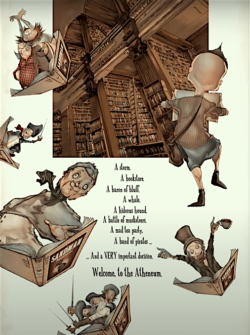
We learn early in life that we shouldn’t judge books by their covers, but of course we do just this when we pick up a book, especially a graphic narrative. Newland’s cover, suitably indebted to a gothic aesthetic, offers a concise précis to his narrative. We are looking at the inside of a “rare and used” bookstore called The Atheneum from a low angle befitting a child: the main hall is dimmed, the cathedral ceiling extraordinarily high, tightly-shelved aisles at right and left frame our sight line to the title. And on the back cover, a list of abridged points summarizing the entire plot: “A storm. A bookstore. A baron of bluff. A whale… and a VERY important decision.”
This “decision,” we soon learn, involves the protagonist, Jack, a boy who, like so many characters in both literature and life, finds himself on a quest. The object of that quest, as Jack learns from the iconic owner of this strange bookstore where he has found serendipitous refuge, is a “voice of your own,” which is the quintessential metaphor for the identity or sense of self that everybody at one point or another in their life’s narrative will try to find. Newland illustrates Jack’s voicelessness as a partial “blank open,” which is the graphic narrative term used to signify a character without much facial expression. The enigmatic tabula rasa where the boy’s mouth should be takes on contours only at the end of the story, though the structure and design of Newland’s panels, as well as the use of graphic weights in the frames, is so enticing that its easy to overlook this detail, as I initially did. As for Jack’s quest to find a voice, it begins with a slip of paper promising “one free adventure of a lifetime!” which the shopkeeper presents him with in an emphatic sentence dramatically presented over three successive frames the illustrations of which are nothing short of cinematic: “You must choose … between the painful persecution … of your voiceless past … or the potential peril of an empowered future.” The shop keeper follows up this directive with an existentially frightening but ultimately empowering line of advice that stands as a motif for the book: “And remember: fortune favours the bold.”
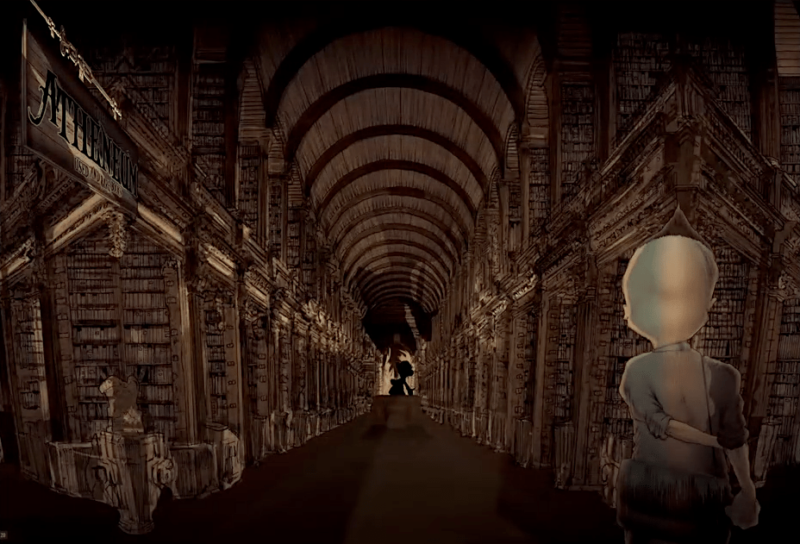
The boldness Jack learns to embrace browsing books at the Atheneum is conveyed in Newland’s energetic and expressive artwork. The setting, as one might imagine for an archetypal bookstore, is more mysterious and obscure than clear and intelligible, indebted more to the chiaroscuro of a Tim Burton film than to typical Walt Disney fare. Newland’s assumed point of view accentuates this obscurity, much like a cinematographer uses canted camera angles or shallow focus shots to signify the temporary disorientation of suspense. For example, Jack’s first foray into the stacks is sublime in terms of both proportion and size. In one early panel, the imposing shelves occupy a thin rectangular frame at the left gutter, with Jack at the bottom looking upward. The successive array of frames, where Jack appears eleven times over the splash page, are precisely laid out in a collage of horizontal and vertical frames, one leading to the next, representing the incremental crescendo of getting lost in the books he pulls from the shelves — Pinocchio, Three Musketeers, Treasure Island, and so on. The drama, which represents the emotion of wonder, culminates in a close up of Jack in a thin rectangular frame at the right gutter, the close up focusing on his eyes and the accompanying facial expressions that characterize being mesmerized by the first book he’s settled on reading, the anonymous 18th century classic, The Extraordinary Adventures of Baron Von Munchausen.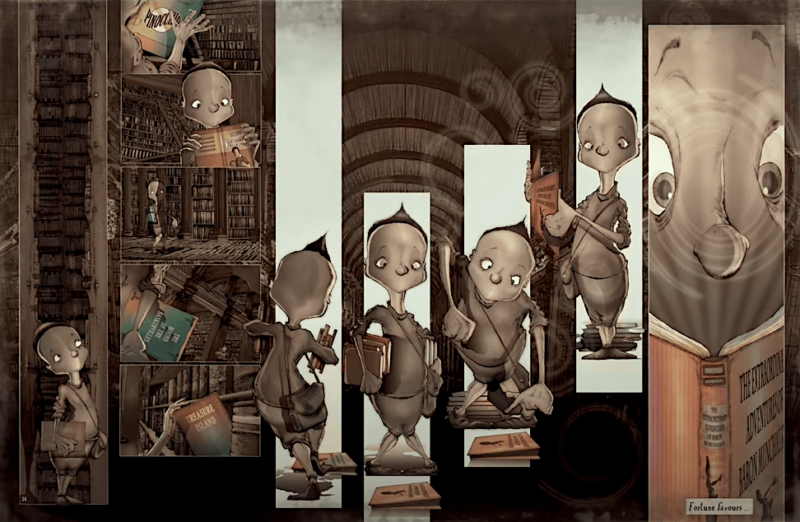

Because graphic novels do not need to tell stories in a linear way and because the activity of reading, contrary to how we might experience it, is hardly a linear activity, we see in many of Newland’s illustrations an original use of transitions between frames that represent the odd and sometimes frantic points of view one experiences with books. For example, with another text Jack picks up and reads, Arthur Conan Doyle’s The Hound of the Baskervilles, we are looking at a series of three horizontal frames, each one capturing the three — then four — silhouetted characters arranged in a theatrical tableaux much as we would see them move across a stage. On the next page, however, the point of view suddenly changes to something that can’t be done in theatre but only in film. We see four vertical frames from a frontal point of view that produces cinematic depth. Frame by frame, this array moves closer in on all three — then again, four — pairs of eyes looking at us look at them, with the final frame being a close-up of a single eye, the conventional graphic weight in any suspense shot.
Newland illustrates the action sequences as if he is inspired by a dynamic blend of Dr Seuss’s exuberant and sometimes nonsensical beauty and Piranesi’s sinister, cavernous architectural forms. The menacing creep factor is always present, thankfully, which I can imagine would be pure delight for young readers who are always more open to the unknown than adults, but it’s never overdone to the point of abandoning hope, as it should never be for children. Terry Pratchett describes “fear” as “hope turned inside out,” and this seems to be a good description of Newland’s art, where the angst in the artwork teeters on the brink of potential dread, much as it does in any Neil Gaiman novel, but is always ultimately contained by the fact that the fear and trepidation exists on the page alone where it can be dealt with through the bold act of reading itself, which is exactly Newland’s point and is the key to Jack finding that voice of his own. Perhaps the strongest visualization of this point appears even before Jack accepts that “one free adventure of a lifetime!” Newland’s narrative voice over text boxes establish that, for Jack, moving “out of the dark” involves only a single question: “The question is … will you be willing to venture into the unknown?”
Here and elsewhere the design brought to mind the pleasing fright of the best Children’s Lit. Like the most frightening moment in Roald Dahl’s Charlie and the Chocolate Factory where Wonka, a moment of exuberant disorientation, recites those beautiful yet sinister lines, “There’s no earthly way of knowing which direction they are going. There’s no knowing where they’re rowing, or which way the river’s flowing.” Newland navigates his narrative similarly. His design at the moment of the narrator’s question features a key hole, with Jack’s inquisitive eye centred: that eye is obviously fretful, even apprehensive, because Jack is stepping into the “unknown” but this also happens to be among the brightest of the panels. The unknown is not, in itself, anything to be frightened of, certainly to the extent that what we are talking about is reading books. And reading involves, before anything else, moving out of the world of experience, to use to William Blake’s terms, and into the relative shelter of reading, which any strong reader will tell you is not at all the same thing as a return to the world of innocence.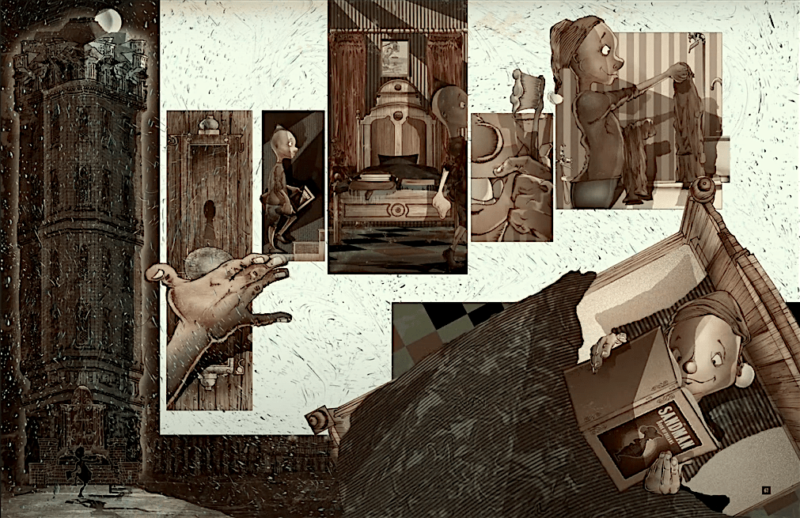
All of this is to say that if I were a young reader I’d be drawn to Newland’s enigmatic illustrations because they communicate the power of the written word — and drawn picture — to transport us, by the seeming magic medium of reading, to an unbounded world of the imagination. Isn’t that exactly what younger readers crave? That is how we are introduced to Jack, at any rate, who we first see in bed reading a book called Sandman Book of Dreams, which functions as narrative frame for his adventure at the bookshop. I’m an older reader, however, and what I found remarkable about The Atheneum is the simple premise underlying Jack’s quest, which is that our sense of identity — our “voice” — is not something inside of us just waiting to be released but is to a great extent the effect of reading. Ultimately, Jack finds his voice from the stories he browses and reads at the Atheneum — Baron Munchhausen, Sherlock Holmes, Alice in Wonderland, and so on — all of which, in a sort of compilation of lessons and character messages, conspire to entertain him but also give him, through the work of imagination and cognition that reading demands, a voice of his own. This is made clear after Jack’s reading adventures near the end, in his response to the shopkeeper’s question about which he has valued more, “The books. Or your voice?” “Both!” Jack replies, which in effect means that both are pretty much the same thing.
The centrality of reading — the centrality of language — is not an easy message to get across to adults, let alone to children, but it’s a lesson that any good writer or teacher of English knows very well. The resolution of Jack’s quest indicates that, for Newland, who is both a writer and a teacher, language is not just an adornment to the “bold” adventure narratives we read, as if a child or any other reader could pull content from a book that is separate from the language in which that that content is written or, in this case, illustrated. Books are not just cultural ephemera that we lose ourselves in, though that’s how we think of them; books enable us to form our own identities, our own voices. It’s not just that reading is a good and fine thing to do. We all suspect that, as Lemony Snicket quips, “Well-read people are less likely to be evil.” That might be part of Newland’s message in this book, but the more salient part is that the process of boldly venturing out to find a voice, the process of growing up or growing into your own self, is fundamentally a linguistic one. “Tell me how you read,” the philosopher Heidegger once said, “and I’ll tell you who you are.” Language and the narratives we spin with it are not supplemental to human consciousness, though that’s often what we’re taught; on the contrary, language is consciousness. This is a point, I suspect, we comprehend better as children when we first set out in the world of reading but that, tragically, we lose by adulthood, perhaps as a result of nothing more than the hubris of our own will.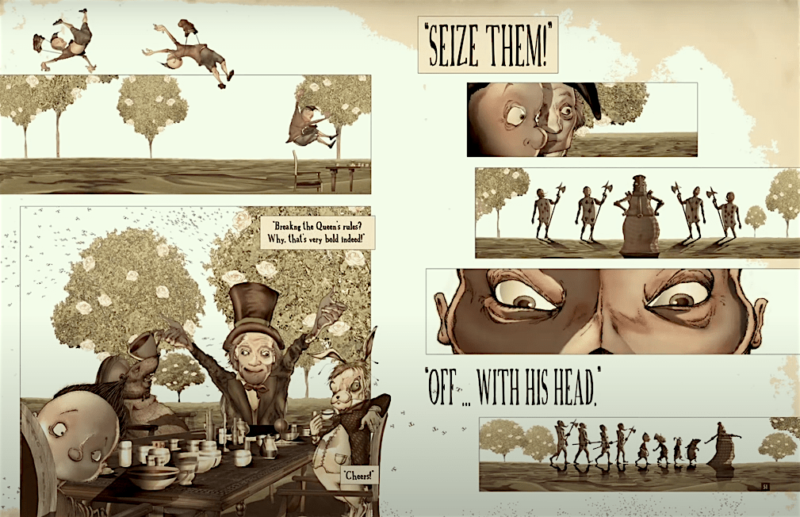
When I arrived at the end of Jack’s quest for a voice of his own, I couldn’t help but think of a lesson I’d read in that other, more effusive character from Children’s Literature, Pippi Longstocking. “Let me tell you,” she says with the boldness that marks all her speech, “it’s dangerous to keep quiet for too long. Your tongue shrivels up if you don’t use it.” Which is true, metaphorically speaking. It’s a point that is vindicated in Newland’s intentionally subtle art in the last pages where the distinction between Jack and the owner of The Atheneum momentarily dissipates; or, rather the two are brought together around the book that has clearly been instrumental for both of them — the Sandman Book of Dreams.
*

Born and raised in the GTA, Peter Babiak now lives and writes in East Vancouver. He teaches linguistics, composition, and English Lit at Langara College, and writes for subTerrain magazine. His commentary and creative nonfiction has been nominated for both BC and national magazine awards and his collection of essays — Garage Criticism: Cultural Missives in an Age of Distraction, published by Anvil Press in 2016 — was a Montaigne Medal finalist and an Honourable Mention in the Culture Category of the Eric Hoffer Awards. His work was selected for The Best Canadian Essays (Tightrope Books) both in 2017 and 2018. He has a dog, a cat, a garden, and an alluring garage. Editor’s note: Peter Babiak has reviewed books by Douglas Coupland, Clint Burnham, Stan Rogal, Jamie Lamb, and Gilmour Walker, and his book Garage Criticism was reviewed by Ginny Ratsoy for The British Columbia Review.
*
The British Columbia Review
Publisher and Editor: Richard Mackie
Formerly The Ormsby Review, The British Columbia Review is an on-line journal service for in-depth coverage of BC books and writers. The Advisory Board consists of Jean Barman, Wade Davis, Robin Fisher, Cole Harris, Hugh Johnston, Kathy Mezei, Patricia Roy, Maria Tippett, and Graeme Wynn. Provincial Government Patron (since September 2018): Creative BC. Honorary Patron: Yosef Wosk. Scholarly Patron: SFU Graduate Liberal Studies.
“Only connect.” – E.M. Forster
3 comments on “1426 Farewell to the silent past”